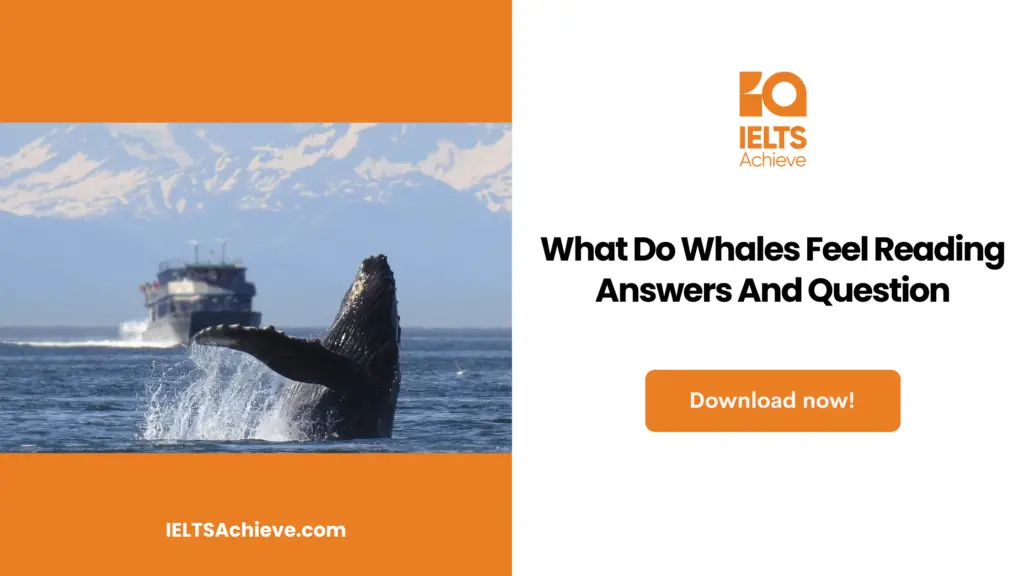The Blog post contains the following IELTS Reading Questions:
- IELTS Reading Note Completion
- IELTS Reading Yes/No/Not Given
- IELTS Reading Matching Headings
Stay informed and prepared for success – Explore our comprehensive Reading Test Info page to get valuable insights, exam format details, and expert tips for mastering the IELTS Reading section.
IELTS reading passage – What Do Whales Feel

What Do Whales Feel?
Some senses in Cetaceans are reduced or are absent or don’t work in water, but we and other terrestrial mammals take these for granted. For example, toothed species are unable to smell which is evident from their brain structure. On the other hand, Baleen species have some similar brain structures but it is not understood whether these are functional. As the blowholes evolved and migrated to the top of the head it has been speculated that the neural pathways serving a sense of smell may have been nearly all sacrificed. The nerves serving these have degenerated or are rudimentary even though some cetaceans have taste buds.
The sense of touch has been sometimes reported to be weak too, but it is mostly mistaken. Trainers comment on their captive dolphins and small whales’ responsiveness to being touched or rubbed. Free- ranging and captive cetacean individuals of all species (particularly adults and calves, or members of the same subgroup) appear to make frequent contact. Stroking or touching are part of the courtship ritual in most species and this contact may help to maintain order within a group. Captive animals often object to being touched around the area of the blowhole as it is sensitive there.
The sense of vision is developed in different species to different degrees. Baleen species, specifically a grey whale calf, studied in captivity at close quarters underwater for a year, and humpback whales and free-ranging right whales, studied and filmed off Argentina and Hawaii, have tracked objects with vision underwater, and they can see to a certain extent both in water and in air. However, the position of the eyes limits the field of vision in baleen whales that do not have stereoscopic vision.
The position of the eyes in most dolphins and porpoises on the other hand, indicates that they have stereoscopic vision downward and forward. The eye position in freshwater dolphins, which often swim upside down or on their side while feeding, suggests that the vision they have is stereoscopic upward and forward. In comparison, the bottlenose dolphin has extremely keen eyesight in water. Judging from the way it tracks and watches the flying fish, it can also see well through the air-water interface as well. Even though the initial experimental evidence indicates that their vision in air is low, the precision with which dolphins spring high to catch small fish out of a trainer’s hand gives anecdotal evidence to the contrary.
With no doubt these variations can be explained with reference to the habitats in which individual species have grown. For example, to species inhabiting clear open waters, vision is more useful than to those living in turbid rivers and flooded plains. For instance, the Chinese beiji and South American boutu appear to have very limited sight, and the Indian susus are blind, their eyes reduced to slits that mostly allow them to recognise only the intensity of light and direction.
Even though the sense of taste and smell appear to have declined, and vision in water appears to be unknown, such shortcomings are compensated for by cetaceans’ well-developed auditory sense. Most species are highly vocal, although they vary in the range of voice they generate, and many hunt their prey using echolocation. Primarily large baleen whales use lower frequencies and are often restricted in their repertoire. The complex, haunting utterances of the humpback whales and the song-like choruses of bowhead whales in summer are notable exceptions. Toothed species in general produce a wider variety of sounds and more frequency spectrum than baleen species (though the sperm whale apparently produces a monotonous series of high-energy clicks and little else). Few of the complicated sounds are also clearly communicative. The role they play in the ‘culture’ and social life of cetaceans has been more of a wild speculation than of solid science.
Unlock your full potential in the IELTS Reading section – Visit our IELTS Reading Practice Question Answer page now!
Recommended Questions:
Renewable Energy IELTS Reading Question with Answer
What Do Whales Feel IELTS reading questions
Questions 1-5
Complete the notes below. Write NO MORE THAN TWO WORDS AND/ OR A NUMBER from the passage for each answer.
Toothed species are unable to 1_______.
Blowholes evolved and migrated to the top of the 2_____.
Captive animals often object to being touched around the area of the 3______.
The sense of 4________ is developed in different species to different degrees.
The bottlenose dolphin has an extremely keen 5________ in water.
Boost your performance in Summary, Notes, Table, and Flowchart Completion tasks. Click here to explore our detailed guide and learn how to effectively complete summaries, notes, tables, and flowcharts in the IELTS Reading section.
Questions 6-9
Do the following statements agree with the information given in the Reading Passage?
Write
YES if the statement agrees with the claims of the writer
NO, if the statement contradicts the claims of the writer
NOT GIVEN if it is impossible to say what the writer thinks about this
6. Stroking or touching may help to maintain order within a group.
7. Captive animals like being touched around the area of the blowhole
8. Dolphins live up to the age of 30.
9. Chinese Beiji and South American Boutu have very limited sight.
Want to excel in identifying the writer’s views and claims? Click here to explore our in-depth guide on how to accurately determine Yes, No, or Not Given in the IELTS Reading section.
Questions 10-15
The reading passage has six paragraphs, A-F. Choose the correct heading for each paragraph from the list of headings below. Write the correct number, i-vii, as your answer to each question.
i. Habitat of whales
ii. Absence of senses in Cetaceans
iii. Voice of whales
iv. Responsiveness to touch
v. Position of eyes
vi. The size of whales
vii. Sense of vision
10. Paragraph A
11. Paragraph B
12. Paragraph C
13. Paragraph D
14. Paragraph E
15. Paragraph F
Ready to conquer Matching Headings questions? Click here to learn essential tips and techniques for matching headings accurately to paragraphs or sections in the IELTS Reading section.
Unlock your full potential in the IELTS Reading section – Visit our IELTS Reading Practice Question Answer page now!
Recommended Questions:
Renewable Energy IELTS Reading Question with Answer
What Do Whales Feel IELTS reading answers
1. smell
2. head
3. blowhole
4. vision
5. eyesight
6. Yes
7. No
8. Not given
9. Yes
10. Paragraph A = ii
11. Paragraph B = iv
12. Paragraph C = vii
13. Paragraph D = v
14. Paragraph E = i
15. Paragraph F = iii

We hope you found this post useful in helping you to study for the IELTS Test. If you have any questions please let us know in the comments below or on the Facebook page.
The best way to keep up to date with posts like this is to like us on Facebook, then follow us on Instagram and Pinterest. If you need help preparing for the IELTS Test, join the IELTS Achieve Academy and see how we can assist you to achieve your desired band score. We offer an essay correction service, mock exams and online courses.

